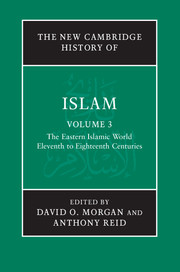Book contents
- Frontmatter
- Introduction: Islam in a plural Asia
- PART I THE IMPACT OF THE STEPPE PEOPLES
- PART II THE GUNPOWDER EMPIRES
- PART III THE MARITIME OECUMENE
- PART IV THEMES
- 15 Conversion to Islam
- 16 Armies and their economic basis in Iran and the surrounding lands, c. 1000–1500
- 17 Commercial structures
- 18 Transmitters of authority and ideas across cultural boundaries, eleventh to eighteenth centuries
- Glossary
- Bibliography
- Index
- References
16 - Armies and their economic basis in Iran and the surrounding lands, c. 1000–1500
from PART IV - THEMES
Published online by Cambridge University Press: 28 March 2011
- Frontmatter
- Introduction: Islam in a plural Asia
- PART I THE IMPACT OF THE STEPPE PEOPLES
- PART II THE GUNPOWDER EMPIRES
- PART III THE MARITIME OECUMENE
- PART IV THEMES
- 15 Conversion to Islam
- 16 Armies and their economic basis in Iran and the surrounding lands, c. 1000–1500
- 17 Commercial structures
- 18 Transmitters of authority and ideas across cultural boundaries, eleventh to eighteenth centuries
- Glossary
- Bibliography
- Index
- References
Summary
Who hath raised up one from the East,
At whose steps victory attendeth?
He giveth nations before him,
And maketh him rule over kings;
His sword maketh them as the dust,
His bow as the driven stubble.
Isaiah, 41:2One salient theme in the military, political and social history of the eastern Islamic world of the late Middle Ages and early modern period is the alteration and even tension between nomadic and standing armies. By the first mentioned, I am referring to armies that are based primarily on soldiers who normally live as pastoral nomads and can be called up to serve at need, as opposed to the latter, armies based in cities, composed of more-or-less professional soldiers. The former mainly receive their livelihood from their pastoral occupations while the latter draw either salaries or revenues derived directly from land allocations under their control. This chapter will revolve around this alternating military situation in various regimes and territories, looking also at the way armies were paid or otherwise supported.
Geographically, Iran – more-or-less defined as the country within the boundaries of the present Islamic Republic, but also including a wide swathe of northern modern Afghanistan and all of Turkmenistan – is at the heart of our discussion. At the same time, the effective influence (and thus the arena for the activities of the military) of these states based in Iran could extend much further to the east, north or west.
- Type
- Chapter
- Information
- The New Cambridge History of Islam , pp. 539 - 560Publisher: Cambridge University PressPrint publication year: 2010



